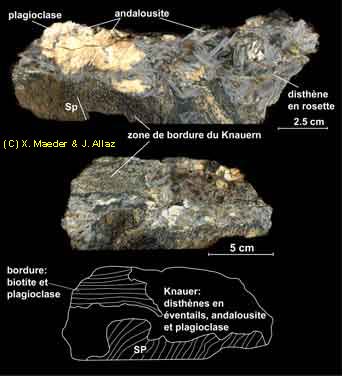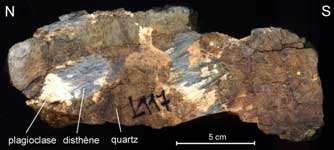|
The crystallisation in these gashes, the pegmatitic texture and the
presence sometimes important of tourmaline are indicator of a crystallisation
from an aqueous fluid (Kerrick 1990 [reference]).
This aqueous fluid has to be rich in aluminium to allow crystallisation
of aluminosilicate
and plagioclase in such abundance. Fluids seem to come from the near
surrounding
rocks and aluminium is probably transported as alcali-aluminous
complex in fluids.
Biotite sometimes forms concentrations along vein border.
These concentrations are interpreted as a rest
of surrounding rocks after impoverishment of alkalis and aluminous
phases
by metamorphic
segregation
(Keller 1968 [reference],
Klein 1976 [reference] et
Kerrick 1988 [reference]).
To start mechanism of vein opening, a weakness zone is necessary,
such as a fracture, shear plane, or pre-existing quartz veins. Release
of local metamorphic fluids generates a fluid overpressure which will
help to open the fracture perpendicular to the local main stress. Release
of pressure in the veins will allow the precipitation of cations dissolve
in metamorphic fluids (Si, Al, K, Na,...) and the crystallisation
of quartz, plagioclase, aluminosilicates and white micas. The cycle
can start again with a next peak of fluid pressure.
|

Enriched border with biotite in a kyanite-,
andalusite- and plagioclase-bearing vein
|



